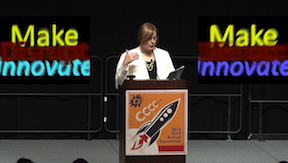
The final remediated video of "Making, Disrupting, Innovating"
Sarah & Erica
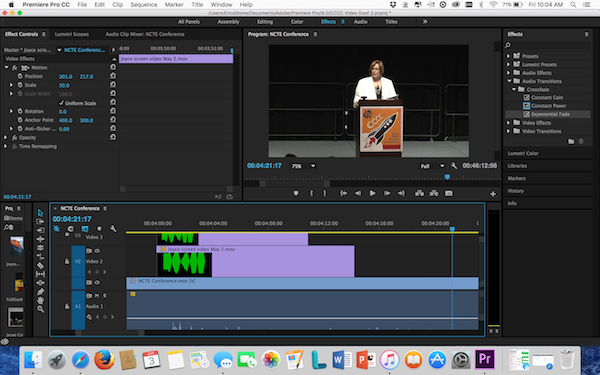
Our initial intention was to make the documentation of Joyce's address accessible to more people across time and space and replicate the address's call to make, disrupt, and innovate. Unfortunately, the remediation process was difficult because we lacked the professional skills needed to craft a video, cut its sound, and simultaneously illustrate the kind of innovation and disruption that we, and Joyce, wanted to exemplify. Tensions arose between what we wanted to do and what we were capable of doing, our visions of what the final product would look like, and between our roles as designers versus graduate students.
The overarching tension we experienced through much of this process was between message and disruption. How could we convey Joyce's ideas of making, disrupting, and innovating without being either too over-the-top or too subtle? The former risked obscuring or completely transforming the message and befuddling, maybe even annoying or angering, the audience, while the latter risked neglecting the potential of the video to enact Joyce's call to disrupt and innovate, rendering it ineffectual. The point we wanted and needed to make was that one can both move an audience to action and prompt thoughtful discussion of what it means to make change. The balance between the two is delicate, and we very nearly shattered this balance on more than one occasion as we mixed sound, distorted video, doctored photos, and tangled with technology and our positions as student–designers.
In the early stages of planning and designing this remediation, this tension between the message and disruption played out in multiple ways, but we focus on two: 1) a tension as we experimented with visual effects and whether they were effectively disruptive or too contrived, annoying, or amateur; and 2) tensions between our visions (Sarah as more disruptive and Erica as more traditional) and between our shared vision of disruption and Joyce's expectations of the video, which led to continual renegotiation and revision.
Originally, we tried to use transitions between frames and varying screen sizes in Adobe Premiere Pro to create a sense of disruption. We added blackout transitions to completely remove all visuals from the screen at one point, while still keeping Joyce's voice audible. We also tried altering Joyce's image so that it was contorted with magnifiers to interrupt the common vision of a speaker behind a podium. In the video excerpt below, you can see some of the transitions we tried out—some quite haphazardly and frenetically. In this 26-second clip, we used eight transition effects: a cross dissolve, a page peel, a page turn, two cross zooms, a center split, a push, and a split.
Such efforts felt overly contrived instead of cleverly disruptive. The following audio clip is an excerpt of the kinds of sustained conversations we had as we were editing the video. In this case, we were playing with the different transition features (like the blackout feature) available in Premiere Pro to see which ones felt disruptive, which ones felt mundane, and which ones were obnoxious or ineffectual.
[the conversational din of Starbucks is in the background, and the audio of Joyce's Address is occasionally audible as they work on editing the video]
Erica: Did that one do anything?
Sarah: I don't know. Make it bigger and let's see—to the right, see if it actually…
Erica: Does anything
Sarah: …shows something. That one… I like that. Let's make it bigger 'cause that was cool.
[Joyce's voice from the video in the background]
Erica: Oh, that was cool!
Sarah: I don't know what that does.
Erica: It’s not…
Sarah: I like that flip-over.… That didn't do anything. Wait, this one does.
Erica: The dip-to-black does but the morphing doesn't do anything. I think it just like does something…
Sarah: Let's make this one—oh, we did make it longer. Ok, that's good.
Erica: But the dip-to-black, you want it even longer? No, it’s not long.
Sarah: Yeah, let's make it longer.
Erica: But back here, this stuff, the morph one, doesn’t do anything.
Sarah: Didn't do anything.
Erica: So, you go. You’re deleted.
Sarah: You delete. And then make this one longer, the dip-to-white. Just pull it that way. Yeah, let's see. Play that.
As the clip demonstrates, we were learning how to use the features of Premiere Pro at the same time as we were trying to create and innovate with them. The result was a tension between knowing how we wanted something to look but not necessarily knowing if the software could do it, and if it could, how to get it to work correctly, as we discuss in technical issues.
Our inexperience also brought up the concern that some of what we considered to be disruptive might be construed as poor editing skills. In one particular instance, the audio of Joyce's voice was misaligned with the video, making the watching of the address comical because her lips, which were visible in particular close up frames of the podium, clearly did not sync with what she was saying. We found this funny, and played with the notion of blurring out her face in parts to make it less obvious, but as we explicitly say in the following audio file, at times, what we were doing wasn't exaggerated enough to be considered intentional, and so it had to be changed.
Joyce: I think that looks a little weird.
Erica: Yeah. So, originally, all of this was just you, at the podium, talking.
Joyce: Sure.
Erica: But then, we were like, oh, she wanted more disruption than this.
Joyce: Right.
Erica: You know, so…
Sarah: And we could take that image and disrupt it differently.
Erica: Yeah. Or is it—or, do you feel like the studio image is…
Sarah: They might not get that this is disruptive. Do you know what I mean? They might think, oh, they just did a bad job with the sound versus this is disruptive.
Erica: So it doesn't seem intentional enough.
Sarah: I can see that. I see how you can argue that.
Another issue we encountered came when we considered mimicking Joyce's real-time address by deciding where and how to display her visualizations. We considered a variety of options, including making Joyce's visualizations take up the right two-thirds of the screen with the podium on the left third of the screen; placing the visualizations over Joyce in the center of the screen (like in the video above); and mimicking the effect in Houston with two visualizations, one on each side of Joyce. We also considered switching effects throughout the video.
But ultimately, we decided on creating two screens, one on each side of Joyce at the podium showing the same variety of disruptive words and images (as they did in Houston). Cutting the images and splicing them into the video wasn't a problem, but trying to get them to be perfectly aligned and symmetrical was difficult. When we moved one, the other would shift too in the same increment. Or, we'd have them aligned at the top edge only to find that one was suddenly a larger size than the other and was a square instead of a rectangle. And while this wasn't the most complex of our technical issues, it took up time simply because we were less well-versed in the use of these programs. We also considered where exactly to place them, concerned that if they were too low, they may create too much symmetry or evoke a cross-like image.
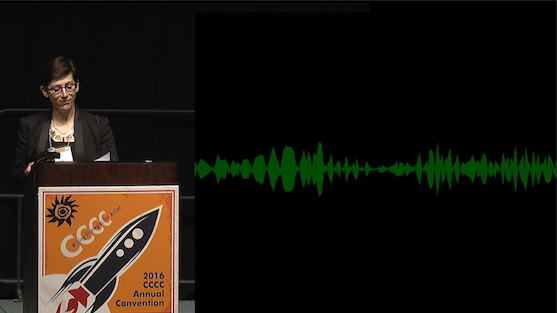
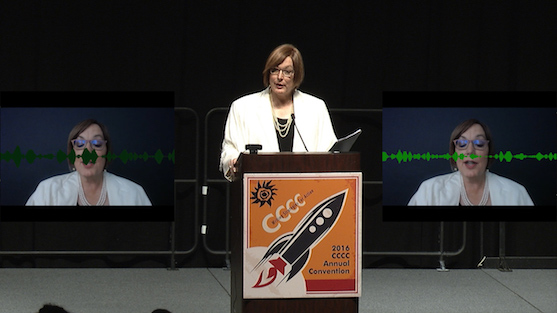
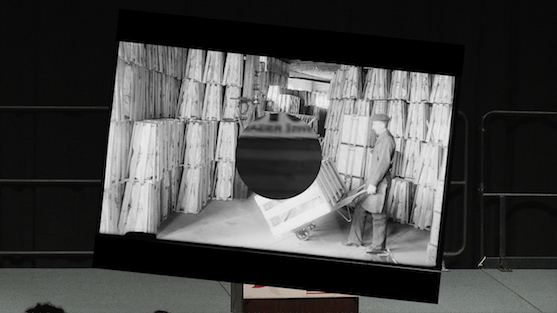
In addition to the problem of our limited skillset was the difference in stylistic choices we brought to Joyce as our client. Not only did we (Erica and Sarah) have differing opinions about how disruptive to be, we also were trying to balance our visions with Joyce's while also meeting (and disrupting) the imagined expectations of our intended audience. When we finally had a working draft to present to Joyce, it aligned to some extent with our understanding of her vision for the video. However, the balance between the styles of traditional documentation and systematic disruption were more difficult than we first imagined, as the next audio clip details:
Sarah: Right, we don't have the podium section.
Erica: So, from a stylistic perspective, I'm sort of a simplistic person, and I like more footage of you at the podium. But that's just me.
Joyce: No, we could…
Erica: I mean, but we didn't want to disappoint with the disruption, you know. We wanted to make sure that…
Joyce: Well, I don't know what people want. I mean, this isn't about me. I've already done my thing. It's about what—
Erica: It is about you. [laughs]
Joyce: Yeah, but people come to look at it, we don't want to be annoying. We want—we want—I don't know… What are your thoughts?
Erica: I just kept thinking that if this is documentation of what happened, then we need to take some out. Some of the gimmicky stuff out.
Sarah: You're such a traditionalist.
Erica: But I'm a traditionalist.
[Sarah laughs]
Erica: I'm like—
Sarah: We're disrupting this!
Erica: This is part of our teamwork, right? Sarah's like, we're disrupting, Erica! We're disrupting! And I'm like, but I want to see what it was like, because I wasn't there.
Joyce: Well, sure.
Erica: So there's that like, dissonance between like the conceptualizing of it versus the documentation part of it.
Sarah: Right. Although I think there's a balance.
Joyce: The split screen solves that problem.
Erica: Maybe it does. Maybe that really does solve the problem. I don't know why we didn't do that before.
Joyce determined at the end of this audio segment that the split screen being visible and showing "disruptive" content acted out the disruption she referenced in her speech, and so this was the ameliorating factor between our traditional versus disruptive dilemma.
Erica found this resolution satisfactory while Sarah was disappointed. That same day, Joyce commented again that she wanted her words to remain intact; she explained that disrupting a speech was important in this case so long as it enhanced the argument rather than completely subsuming it. To illustrate this point, Joyce mentioned the cute kitten memes that pervade the Internet. She said that the meaning of the meme itself is often lost because the mere presence of the fuzzy kittens distracts from any possible message communication. After that, as this next audio excerpt shows, Sarah began to come around, and we began working from a slightly more traditional and much more focused place.
Erica: At which point do you disrupt so much that you lose—
Sarah: The message—
Erica: the message—
Sarah: loses the meaning, the argument disappears.
Erica: Yeah.
Sarah: Or it's distracted—like Joyce said, the kittens thing. At some point, you stop listening to what the person says because the other thing is so interesting or distracting. And at that point, the argument is no longer a success because they're not hearing it.
Erica: And she had said several times, I don't want to lose my words. I worked hard on those words. There's a lot of them. I don't want to lose the message and the words that she wrote down. Even though—
Sarah: She's emphasizing disruption and innovation. She's still an author. She's still a writer.
Erica: Hmm. And you can't lose that part of it.
Sarah: Well, we're not willing to. I wonder if you can and still have your message have a point.

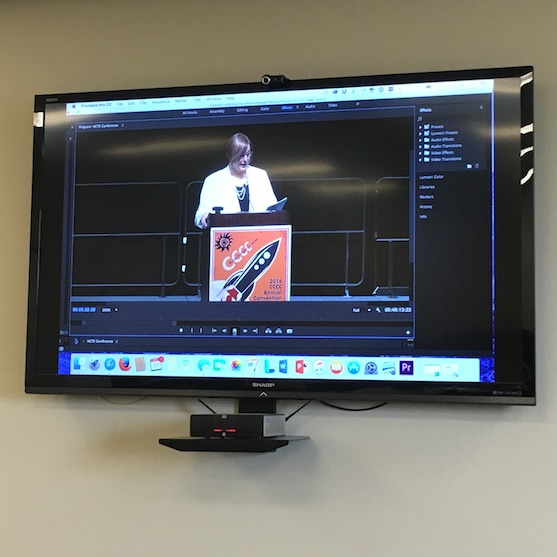
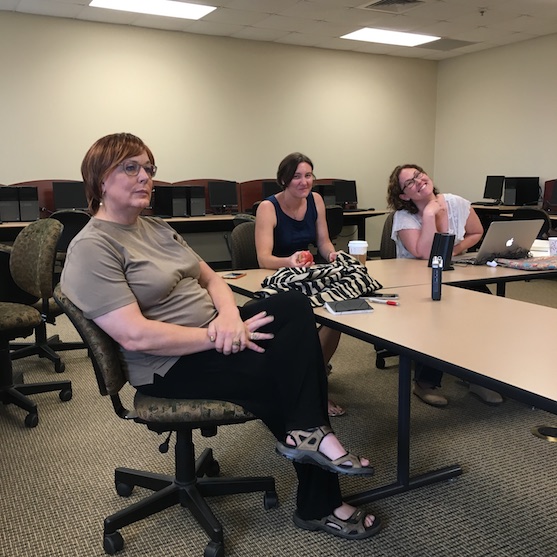
We were struggling with our perceived disconnect between being designers with a high-profile client and being first-year doctoral students working with a well-known and highly respected scholar and leader in technical communication, rhetoric, and composition. During our many musings, Erica commented that this remediation "is all about Joyce as the CCCC Chair," and indeed we did not want to disappoint her. However, those feelings were entirely from the tension we felt as graduate students, not as designers working with a client.
This tension is one that still exists for us now as second-year students and is one that many graduate students grapple with as they begin to collaborate with mentors and professors and embark on the transition from "imposter" to member of the field. We have no precise wisdom to impart on this reality except to comment on its existence as commonplace and but one aspect of the process students take as they enter academia. Once we acknowledged that the dissonance here was based largely on our current status in the field and at our institution, we were able to move forward with the more tangible and immediate concerns we were facing revising and editing the video.